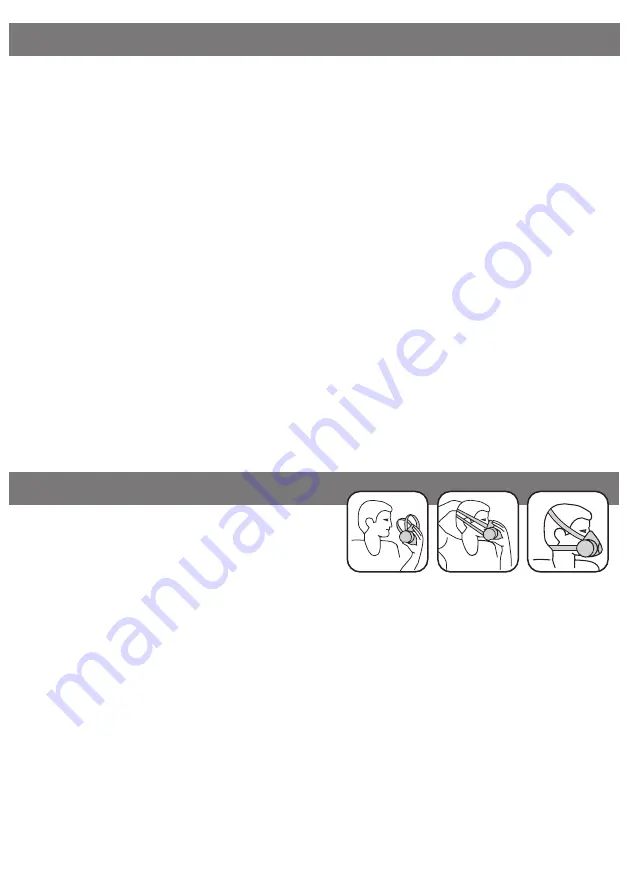
LIMITACIONES
LIMITATIONS
El equipo no suministra aire respirable, en cambio, purifica el aire existente cuando pasa a través del filtro.
Es importante determinar la siguiente información antes de su uso:
- Identificar la naturaleza de las sustancia(s) que puede(n) estar en el entorno de trabajo.
- La concentración máxima de las sustancias tóxicas que pueden estar en el entorno laboral.
- Que no haya suficiente oxígeno en el área de trabajo.
- El valor límite umbral (TLV) para cada sustancia identificada.
- La cantidad de tiempo necesario con el conjunto de máscara-filtro.
Nunca se quite el respirador por ninguna razón mientras se encuentre en el área de trabajo. Abandone el área de
trabajo inmediatamente si el sello entre la máscara y el rostro se rompe por alguna causa, como por ejemplo:
a. La máscara se desliza como consecuencia de una sudoración excesiva o de movimientos excesivos realizados con
la cabeza.
b. La máscara se le cae por un golpe recibido.
c. Estornuda o tose mientras lleva puesta la máscara.
d. Necesita sonarse la nariz, rascarse en un lugar cubierto por la máscara o ajustarse su equipo de lentes.
e. Cualquier otra actividad que pudiera romper el sello hermético de la máscara.
- Antes de volver a ingresar en el área de trabajo, debe crear de nuevo el sello entre la máscara y el rostro y realizar
una prueba de ajuste en un lugar que no represente ningún riesgo.
The mask and filter set is designed for entering polluted environments with an oxygen content of over 19.5%. The set does not supply breathable air,
instead, it purifies the existing air when it passes through the filter. It is important to determine the following information before use:
- Dentify the nature of the substance(s) that may be in the work environment.
- The maximum concentration of toxic substances that may be in the work environment.
- That there is enough oxygen in the work area.
- The threshold limit value (TLV) for each substance identified.
- The amount of time the mask-filter set will be required.
The respirator for any reason will not remove while you are in the work area. Leave the work area immediately if the seal between the mask and the
face is broken for any reason, such as:
a. The mask slips due to excessive sweating or excessive head movements performed.
b. The mask falls from a blow.
c. Sneeze or cough while wearing the mask.
d. You need to blow your nose, scratch in a place covered by the mask or adjust your team lenses.
e. Any other activity that would break the tight seal of the mask.
- Before re-entering the work area must recreate the seal between the mask and the face and perform a fit test in a place that does not pose any risk.
COLOCACIÓN Y AJUSTE
PLACEMENT AND ADJUSTMENT
Para el correcto uso, el respirador debe adaptarse a la forma
de la cara: sostenga la mascarilla de tal forma que la parte
estrecha del triángulo de la nariz apunte hacia arriba (1),
tome las dos correas que cuelgan de la parte inferior del
respirador y engánchelas detrás del cuello (2) coloque la
correa superior arriba y la inferior detrás de la cabeza (3). Tire suavemente de las correas para ajustar su longitud.
For correct use, the mask should fit the shape of the face: hold the mask so that the narrow part of the triangle of the nose points up (1), take the two
straps hanging from the bottom of the respirator and hook behind the neck (2) placed above the upper belt and the lower back of the head (3). Gently
pull strap to adjust their length.
Prueba de presión positiva
- Bloquee la rejilla de escape con la palma de la mano y exhale lentamente con la fuerza suficiente para causar una
suave presión positiva dentro de la parte interna de la mascarilla. Si la mascarilla se infla ligeramente y no detecta
ninguna fuga entre la cara y la mascarilla, se ha obtenido un ajuste apropiado.
Prueba de presión negativa
- Bloquee la rejilla o rejillas de inhalación con las palmas de las manos inhale lentamente durante 10 segundos. Si la
mascarilla se colapsa ligeramente y no detecta fuga de aire entre su cara y la mascarilla, se ha obtenido un ajuste
apropiado.
SI DETECTA FUGA DE AIRE ENTRE LA CARA Y LA MASCARILLA DEL RESPIRADOR, CÁMBIE LA POSICIÓN Y AJUSTE LAS
CORREAS PARA OBTENER UN AJUSTE MÁS SEGURO. SI NO OBTIENE UN AJUSTE APROPIADO, NO UTILICE EL
RESPIRADOR.
Positive pressure test
- Lock the exhaust grille with the palm of the hand and slowly exhale with sufficient force to cause a slight positive pressure within the inside of the
mask. If the mask is slightly inflated and not detects any leakage between the face and the mask, has obtained a proper fit.
Negative pressure test
- Lock the grid or grids inhalation with the palm of the hand inhale slowly for 10 seconds. If the respirator collapses slightly and no air leakage detected
between your face and the mask, has obtained a proper fit.
IF YOU DETECT AIR LEAK BETWEEN THE FACE AND THE MASK RESPIRATOR, REPOSITION AND ADJUST THE STRAPS FOR SAFER. IF YOU GET A PROPER
FIT DO NOT USE THE RESPIRATOR.
2
1
3










